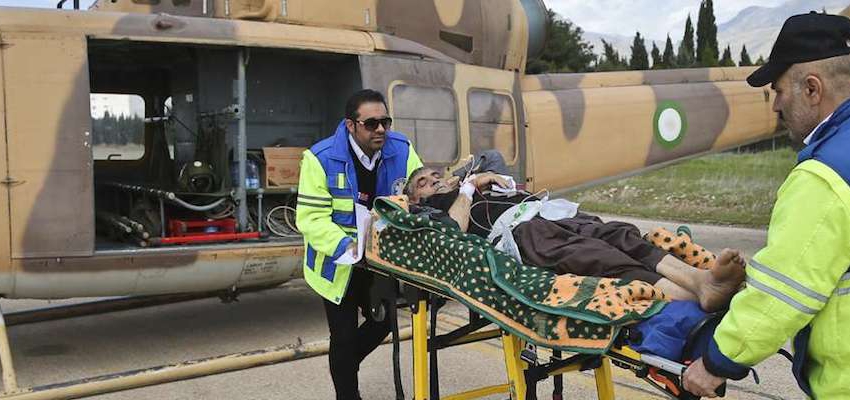Saturday 6 April 2019 - 15:28
Story Code : 344006
Lack of helicopters shows sanctions impact on Iran flood response
Pompeo�s statement appears to have been spurred by reports that the Iranian Red Crescent Society (ICRS) is unable to accept international aid due to a lack of viable banking channels.� Ali Asghar Peyvandi, the head of the Iranian Red Crescent Society, told reporters in Iran that �Prior to the [reimposition of US] sanctions, we had some Red Crescent accounts connected to SWIFT, and we sought international aid through them. However, at present, these�accounts have been sanctioned�and there is no possibility for money transfers from other countries.�
These statements have led to questions as the role sanctions may have played in Iran�s unconvincing response to unprecedented floods, which have killed over 50 people and caused widespread devastation. But in the context of rescue and relief operations, the ability to raise funds after a disaster matters far less than the level of preparedness before the disaster, especially in a country like Iran with its substantial financial resources. So even if sanctions are impeding the delivery of financial aid, a more important question is whether or not sanctions had a meaningful impact on preparedness. A look at Iran�s failure to procure rescue helicopters helps answer that question.
On Tuesday, Iranian Foreign Minister Javad Zarif pointed to sanctions-related impediments in a tweet, stating, �Blocked equipment includes relief choppers.� Placing blame on the US, Zarif declared,�"This isn't just economic warfare; it's economic TERRORISM.� Zarif�s anger likely stems from the fact that Iran had attempted to purchase much-needed search-and-rescue helicopters over the last few years, but was thwarted by both the failed implementation of sanctions relief under the JCPOA as well as the reimposition of sanctions by the Trump administration.
The Iranian Red Crescent Society (IRCS) operates an air rescue fleet that it has long needed to modernize. In 2015, with the prospect of sanctions relief on the horizon, IRCS approached foreign suppliers with the intention to purchase 28 new helicopters to augment its fleet of Russian-made Mil Mi-171 cargo helicopters and Iranian-made Bell-412 utility helicopters. Airbus Helicopters came forward as an early suitor and collaborated with ICRS on corporate social responsibility projects to help build trust. In 2016, the Airbus Foundation and ICRS launched a program to �to train thousands of Iranian teenagers aged between 12 and 14 in robotics and resilience techniques, developing their skills to respond to disasters and ensuring safer and more resilient communities for the future.� Even American defense contractor Lockheed Martin, parent company of helicopter-maker Sikorsky, publicly stated that it was studying the feasibility of selling civilian helicopters to Iran.
In 2017, drawing on new funding made available by parliament, the Iran�s Ministry of Health sought to purchase 45 BK-117 air ambulances from Airbus Helicopters configured for rapid response to accidents and medical emergencies in urban areas. A report on the delivery of the first two aircraft notes that Iran had just 21 air ambulances in operation at the time. Just a couple months later, in November 2017, a massive earthquake hit Kermanshah, killing 600 and once again demonstrating the urgency for Iran to upgrade its search-and-rescue capacity.
But the continued presence of US primary sanctions made it difficult for Iran to secure financing for the ICRS and Ministry of Health helicopter acquisitions, slowing the delivery of the aircraft. Helicopters can also be considered �dual-use,� given possible military applications of key parts, and so the deals were subject to significant scrutiny by US and European regulators.� Just 8 helicopters had been delivered to the Ministry of Health by Airbus by the time that the Trump administration withdrew from the JCPOA nuclear deal and reimposed secondary sanctions on Iran. ICRS did not take delivery of any new helicopters.
Today, ICRS has responded to the unprecedented flooding in Iran with just �23 rescue and relief helicopters,� which are spread thinly across multiple provinces as they deliver supplies and transport the injured to medical facilities. ICRS�s old fleet lacks night vision technology, meaning that only Iran�s military can run rescue operations at night.
Importantly, Iran�s disaster relief agencies were aware of such shortcomings and have tried to address them. Between 2005-2015, the United Nations spearheaded a �global blueprint for disaster risk reduction efforts� called the Hyogo Framework for Action (HFA). Iran was among the 168 participating countries, which undertook a systematic evaluation of their disaster readiness.
Iran�s final assessment report, published in 2013, evaluates Iran�s level of disaster preparedness in regards to whether �financial reserves and contingency mechanisms are in place to support effective response and recovery when required.� The report notes encouragingly that Iran has set aside �national contingency and calamity funds.� But key constraints include �international sanctions and restrictions and lack of cooperation in providing humanitarian equipment� as well as �insufficient equipment when a large-scale disaster happens.� Put more simply, the report concludes that while sanctions have a limited impact on the availability of financial resources for disaster response, they have a serious detrimental impact on the ability to procure adequate rescue equipment. The effort to acquire new helicopters in the brief period in which Iran was provided sanctions relief reflects an attempt to address such shortcomings.
Discussing the impact of sanctions on the rescue operations after the recent floods does not deflect from the Iranian government�s ultimate responsibility for the ineffective response to the disaster. Nor does it excuse the negligence that created longstanding vulnerabilities, such as failing to ensure �risk sensitive regulation in land zoning and private real estate development,� shortcoming identified in Iran�s HFA report. But sanctions will remain even when the floods subside. It is imperative for American policymakers to account for the ways that �maximum pressure� policies directed towards Iran will continue to complicate Iran�s efforts to prepare for the next natural disaster. Facilitating donations will mean little if Iran is unable to procure the equipment that will make its disaster response more effective in the next instance.
# Tags











